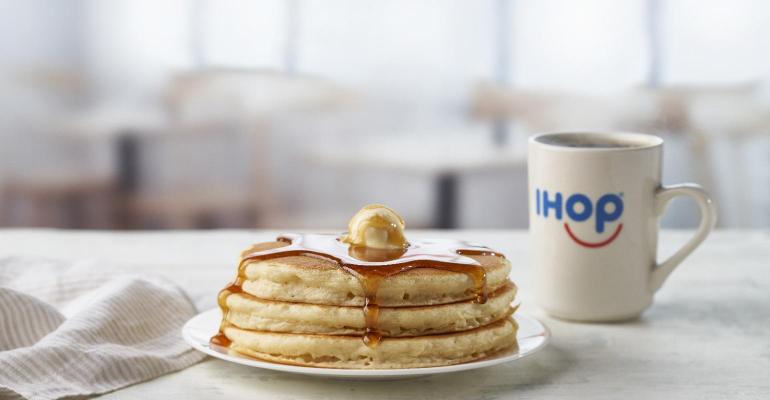Dine Brands, parent company of Applebee’s, IHOP, and Fuzzy’s Taco Shop, reported Q3 results Wednesday morning, including a 2.4% drop in same-store sales at Applebee’s, and a 2% same-store sales increase at IHOP.
IHOP’s 10th consecutive quarter of same-store sales gains were driven by the company’s massive menu refresh earlier this year. Both brands’ weekly sales surpassed pre-pandemic highs, with Applebee’s up over $52,000 and IHOP weekly sales at $37,800. This was one of the highlights for Dine CEO John Peyton, who attributed the increase in weekly sales to a significantly larger off-premises business and higher menu prices – which are about 4% higher year-over-year at Applebee’s and about 8% for IHOP.
During an interview Wednesday afternoon, Peyton added that Applebee’s is now achieving the same in-store traffic levels as it was in 2019, while IHOP is “getting close.” Though the company doesn’t disclose traffic data, he said it is a focus for both brands as part of their promotional strategies, which recently included the All-You-Can-Eat Boneless Wings and Dollarita promotions at Applebee’s and drove quarter-over-quarter traffic improvement.
Also, traffic started to decline industrywide around the beginning of the third quarter, but Peyton said Dine Brands’ core customers – who fall within a household income level of about $50,000 to $75,000 – have shown “no significant changes.”
“When we look at all of our sources of data – loyalty program, point-of-sale, third-party data – we can see that our guests … spent a little less on QSR but were still consistently coming to us and maintaining their average check,” Peyton said. “My interpretation of that is in a time in which consumers are being careful about their wallets, when they do go out, they want an experience. That mindset of an experience, that’s one of Dine’s core strengths.”
Also, Applebee’s and IHOP’s promotions, namely the Dollarita at Applebee’s and the pancake tacos at IHOP, have continued to drive new and younger consumers into both brands. IHOP, for instance, sold two million pancake tacos in four weeks and garnered one billion impressions on social media.
“That’s a big number for us. These promotions are all about bringing new guests into the restaurant and they overindex with new guests and Gen Z, which is what we want to do,” Peyton said.
In addition to gaining traction from its menu innovations and expanded guests, IHOP’s loyalty program – the International Bank of Pancakes first launched in spring 2022 – now counts 7 million members. This provides the brand with deeper insights into its consumer behaviors, which has informed the brand’s menu updates as well. All of those menu updates, by the way, haven’t impacted operations, Peyton said.
“Both a focus on menu innovation and simplification can exist at the same time. Our kitchen is efficient if we roll out a new category, like crepes for example, and use that data about which items in the category sell best and which don’t. It’s a cycle,” he said.
He also said value can exist without discounting, which is the balance both Applebee’s and IHOP strike when introducing limited time offers or bundles.
“We make sure our promotions are compelling to attract new and existing guests and are also profitable without putting the menu on sale,” Peyton said. “Anything we do on a promotion or LTO is always done in conjunction with our franchisees. We construct and approve them together.”
And, those franchisees want to continue to grow both brands, but development continues to be hindered by construction and permitting delays that have impacted the entire industry. For instance, the domestic development target for IHOP’s net new openings is about 20 to 30, versus 45 to 60 net new openings previously expected. Despite the delays, Peyton remains bullish on the long-term growth of both brands and the company is focusing more on conversions to circumvent some of those challenges and drive development. During the earnings call, Applebee’s president Tony Moralejo said three of the last four openings were conversations and generated higher average unit volumes than the system’s average.
Both brands are also working on new, more efficient prototypes. Peyton said those efficiencies – both cost and operational efficiencies – will mostly come from the back-of-the-house.
“We have a great design in the front-of-house we’re all proud of, so the work and those savings are going to come from the back-of-house. It’s a work in progress for us and we’re looking at automation, robotics, the most current equipment specs so we can make kitchens more efficient, smaller and increase throughput,” Peyton said, noting there are no further updates at this time on what that automation/robotics piece could look like. “We’re focusing on the mechanics.”
Fuzzy’s Taco Shop
Not to neglect Dine Brands’ newest chain, Fuzzy’s recently unveiled a new “Baja” strategy that will include new restaurant design elements, a menu refresh and guest experience enhancements. Testing will begin in Q4 with a full national rollout planned for Q1 2024.
By the numbers
Peyton said highlights for him for the quarter included EBITDA (earnings before interest, taxes, depreciation, and amortization) exceeding expectations and a solid cash flow amid a challenging backdrop. Adjusted EBITDA was $60.6 million compared to $63.6 million in Q3 2022, impacted by refranchised restaurants. Consolidated total revenues, excluding the refranchised Applebee's restaurants, increased to over $200 million in Q3 versus $195 million in the prior year.
Total revenues decreased 13% to $202.6 million compared to $233.2 million in Q3 2022, again, primarily due to the refranchising of Applebee's restaurants in October of 2022.
Contact Alicia Kelso at [email protected]

